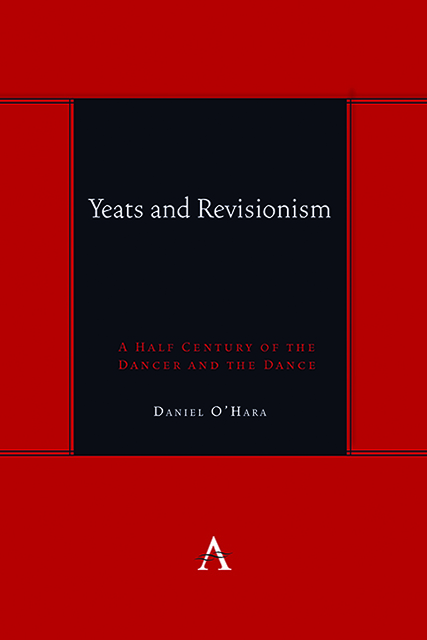Book contents
- Frontmatter
- Dedication
- Contents
- Acknowledgments
- Preface
- Introduction: Dancer and Dance: Yeats’s Romantic Modernism and Critical Revisionism
- Chapter 1 The Irony of Tradition in W.B. Yeats’s Autobiography: Dialectical Hermeneutics Beyond the New Criticism
- Chapter 2 The Specialty of Self-Victimization: On Antithetical Revisionism
- Chapter 3 Yeats in Theory: Blackmur, Bloom, De Man and Hartman
- Chapter 4 The Divisions of Yeats Studies Continued
- Chapter 5 Modernism’s Global Identity: on the Dogmatic Imagination in Yeats, Freud and Beyond
- Chapter 6 Yeats With Lacan: Toward the Real Modernism
- Chapter 7 The Spirit Medium: Yeats, Quantum Visions and Recent Lacanian Studies
- Chapter 8 And All the Ceremonies to Come: Of High Modernism, Visionary Violence and Post-Marxism
- Afterword: The Reader in Yeats
- Bibliography
- Index
Chapter 8 - And All the Ceremonies to Come: Of High Modernism, Visionary Violence and Post-Marxism
Published online by Cambridge University Press: 08 June 2023
- Frontmatter
- Dedication
- Contents
- Acknowledgments
- Preface
- Introduction: Dancer and Dance: Yeats’s Romantic Modernism and Critical Revisionism
- Chapter 1 The Irony of Tradition in W.B. Yeats’s Autobiography: Dialectical Hermeneutics Beyond the New Criticism
- Chapter 2 The Specialty of Self-Victimization: On Antithetical Revisionism
- Chapter 3 Yeats in Theory: Blackmur, Bloom, De Man and Hartman
- Chapter 4 The Divisions of Yeats Studies Continued
- Chapter 5 Modernism’s Global Identity: on the Dogmatic Imagination in Yeats, Freud and Beyond
- Chapter 6 Yeats With Lacan: Toward the Real Modernism
- Chapter 7 The Spirit Medium: Yeats, Quantum Visions and Recent Lacanian Studies
- Chapter 8 And All the Ceremonies to Come: Of High Modernism, Visionary Violence and Post-Marxism
- Afterword: The Reader in Yeats
- Bibliography
- Index
Summary
The definition of high modernism informing this essay takes as its familiar historical basis the period roughly beginning in 1910 and ending in 1930. This 20-year period is admittedly rough, marked at its opening by the death of Edward VII and at its close by the full onset of the first worldwide Depression, and haunted by the violent specters of the Great War. Its seeds clearly start to grow earlier, whether one takes the 1890s of the aesthetes and Decadents or, even earlier, the revolutionary era of Romanticism. So too with the other temporal marker 1930, given that what we now call late modernism or proto-postmodernism is soon enough emerging, displaying as many confusing similarities as differences. By focusing on literary modernism largely in the Anglo-American tradition, which benefits from its position in the imperialist network, my hypothesis tightens the parameters further. What about other modernisms, or the other arts, painting and music especially? I will address the latter a bit later in this essay.
I focus more closely on literary modernism here because as modernism emerges its essential elements appear more distinctly and, for my purposes, more relevantly, with respect to a long-term project on Yeats. Getting modernism and Yeats right for this project's sake, however, is not simply a professional or personal goal. It is also a critical intellectual effort to demonstrate how in a time rife with violence, radical skepticism about liberal democracy, terrorisms of various sorts and demagoguery and irresponsibility in the extreme, art, politics and spiritual or metaphysical beliefs may work together in ways that are for us still humanely instructive and humanly formative. Facile dismissals of certain artists or works and what their life projects disclose should thereby be harder to make as we learn to appreciate and understand, after careful reading as well as judge fairly or condemn where truly warranted. The violently reductive critical judgment, hastily and carelessly made, may not be a terrorist bomb, but it can have long-term consequences, intended or not, which distort and inhibit the critic's humanity and eventually that of the larger society. We need no more additions to any modern moment's debasement.
The features of modernism then, whether within this particular frame or a wider, more global and seemingly more diverse context, are for the most part, primarily four. These are: (1) a formal aesthetic of ironic self-reflection;
- Type
- Chapter
- Information
- Yeats and RevisionismA Half Century of the Dancer and the Dance, pp. 135 - 152Publisher: Anthem PressPrint publication year: 2022



